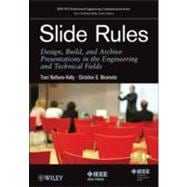
What is included with this book?
TRACI NATHANS-KELLY, PhD, teaches engineering communication at Cornell University and the University of Wisconsin-Madison.
CHRISTINE G. NICOMETO, MS, teaches technical communication in the University of Wisconsin-Madison’s College of Engineering.
Both authors work with practicing engineers from such organizations as 3M, Federal Express, GE Healthcare Systems, General Motors, Google, Harley-Davidson, IBM, John Deere, Kraft, Lockheed Martin, Micron Technology, NASA, Qualcomm, Rockwell Automation, The Boeing Company, Toyota, U.S. Department of Defense, and UTC Aerospace.
Dedication
Acknowledgements
Foreword
Introduction
Slide Rule #1: Revisit Presentation Assumptions
Chapter 1: Head the Pleas for Better Presentations
Know the enemy
Be an agent of change
Call a meeting instead of summoning a slide deck
Destroy the decks of drudgery
Learn communication lessons from past tragedies
Sidebar: From the Trenches
Confront conventional poor practices
Consider slides as a two-part deliverable
Implement your own continuous improvement
Chapter References
Chapter 2: Apply Cognitive Science and Tell a Story
Change presentation practices using grounded research
Stay open to change
Revisit how a slide works
Design slides for the audience’s cognitive load
Lessen cognitive load with storytelling
Apply science and storytelling
Chapter References
Chapter 3: Understand Audience Needs
Scope content towards identified purpose
Sidebar: From the Trenches
Learn about your audience first
Determine the presentation’s purpose
Determine the goals for a talk
Elevate the moment
Sidebar: From the trenches
Assess the audience
Prepare for a familiar audience
Sidebar: From the Trenches
Prepare for an unfamiliar audience
Coping when your talk gets hijacked
Ditch the “dumb it down” attitude
Think of audience needs, not yours
Think about logistics
Chapter References
Chapter 4: Challenge Your Organization’s Culture of Text-Heavy Slides
Understand the pattern’s origin
Stop assuming they want to read
Sidebar: Notes from a Novice
Work towards fewer bullets, less text
Avoid using slides as teleprompters
Build information deliberately
Move beyond “How many slides should I use?”
Encourage better presentation practices
Create, compile, organize, and stabilize team presentations
Work towards a change
Chapter References
Slide Rule #2: Write Sentence Headers
Chapter 5: Clarify Topics with Full-Sentence Headers
Write full sentences for headers, avoiding fragments
Consider the case against fragmented headers
Deploy best practices for sentence headers
Expect immediate results
Write targeted headers
Influence outcomes with headers
Frequently asked questions about sentence headers
Chapter References
Slide Rule #3: Use Targeted Visuals
Chapter 6: Build Information Incrementally
Build something better than bullets
Devise methods that build information
Design with words to make bullet lovers happy
Solidify complex topics with refrains
Use refrain slides for meeting agendas
Build visuals for directed comprehension
Build out to drill down
Chapter 7: Generate Quality Graphs
Portray complexity simply
Determine the right visual
Sidebar: The value of visualization
Design reasonable pie charts
Design impactful bar charts and histograms
Sidebar: Transformation—Creating quality bar charts
Design scatter XY charts and scatter plots
Sidebar: Transformation—A chart grows up
Craft line charts
Map out area graphs
Think through flow or process charts
Address assorted other visual outputs
Graph ethically
Create accessible graphs
Sidebar: Testing graphics for color-blindness accessibility
Frequently asked questions about graphs
Chapter References
Chapter 8: Picture the Possibilities
Picture your information
Center yourself
Manage image interpretation
Model accurately
Be ethical with visuals
Frequently asked questions about using pictures
Chapter References
Chapter 9: Temper the Templates
See the possibilities in a template, branded or otherwise
Discover and assess a branded template
Work with company templates
Devise solutions for problematic templates
Fix the template
Provide template guidance
Refine quad slides
Establish brand when there is no template
Chapter References
Slide Rule #4: Archive Details for Future Use
Chapter 10: Make Slide Decks with Archival and Legacy Value
Understand that slides have two lives
Start new best practices
Document ideas efficiently
Use the Notes or Presenter Notes feature
Get others to see your notes
Sidebar: Caution—The Inside doc/Outside doc
Use hidden slides
Keep hidden slides ready
Make retrieval easy for everyone else
Embrace full documentation as a part of workflow
Chapter References
Chapter 11: Include More Than One Language
Know when English is not enough
Start with audience analysis
Anticipate formatting for translations
Deploy plain language
Write in one language and talk in another
Design split slides
Capture translation in notes
Translate towards clarity
Find resources
Chapter References
Slide Rule #5: Keep Looking Forward
Chapter 12: Enact Organizational Change
Listen to the studies
Anticipate the stages of acceptance
Tally the results
Look for the opportunities
Chapter References
Chapter 13: Thinking Through the Next Big Thing
See ahead
Play with Prezi
Use caution
Amaze with Autodesk
Apply apps
Remain diligent in your best practices
The New copy of this book will include any supplemental materials advertised. Please check the title of the book to determine if it should include any access cards, study guides, lab manuals, CDs, etc.
The Used, Rental and eBook copies of this book are not guaranteed to include any supplemental materials. Typically, only the book itself is included. This is true even if the title states it includes any access cards, study guides, lab manuals, CDs, etc.